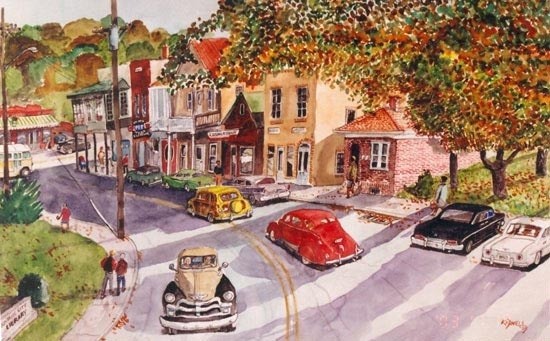Probably most of us have wished at some time that we could recapture some of the scenes and some of the experiences of our youth. One ex-Fountain Citian, Bill Kidwell, is doing just that. He has completed the first six of 12 watercolor paintings of Fountain City in the 1950s. His paintings capture the essence of scenes from his youth. Hopefully, the reader, too, will remember with pleasure these same scenes.
Kidwell was born in Knoxville on July 27, 1934. His aptitude for art dates to his first project, a Crayola mural on his grandmother Collins’ front door on Ocala Drive in Old Fountain City when he was only 2 years old. His talent was obvious even at that early age, and throughout his childhood he was constantly drawing and painting.
Kidwell attended Fountain City Elementary School and Central High School, graduating in 1954. He recalls that his first-grade teacher, Miss Moore, encouraged his artistic bent and credits Central High School art teacher Virginia Wilson who assisted him in developing his technique. After high school, Bill served in the U.S. Marine Corps for 3-1/2 years, then entered the University of Tennessee where he majored in painting with a minor in art history. Soon C. Kermit Ewing, UT professor and well-known local artist, hired Bill as an assistant in the art department.
In 1958, after he suffered a serious injury to the first three fingers of his right hand during a dress rehearsal for a Carousel Theater play, “Stalag 17,” it was necessary for him to leave school. He became the seventh and eighth grade science, health and art teacher at Vestal Junior High and coached the basketball team. After two years he resigned and moved to Miami, Florida, briefly and then to the Los Angeles area to become a technical illustrator for Lockheed Aircraft at Burbank. Soon he moved up to department manager and by his fourth year he was working on the top-secret SR-71 Blackbird Project.
Desiring to pursue his career in art full-time, he left Los Angeles in 1964 and moved to Mazatlan, Mexico, after reading an article in “Life Magazine” on an art colony there. He was disappointed to find that there was no art colony, not even an art supply shop, so he returned to the University of Tennessee to complete his art courses.

Bill Kidwell and his wife, Lizabeth
After finishing UT in 1966, he traveled the eastern U.S. from Maine and Canada to New Orleans, painting various scenes and photographing others for future works. After a sojourn in New Orleans, he moved to Berkeley, California, and sold watercolors and drawings to individuals and corporations. During this time, his work was published in several Bay Area periodicals. As he lived on a 40-foot sailboat at Sausalito, his maritime paintings were inspired by the harbor scenes he viewed daily. Later he moved to Santa Ana in Southern California and occupied one of the last orange grove farm houses to remain in that historic part of the state. Then he lived for a time in Taos, New Mexico, where he established a gallery connection and experienced robust sales of his Southwest work.
Eventually, his roots in Knoxville brought him back home where he established a studio on Fort Loudoun Lake and spent some time organizing all the materials he had collected in his travels. A successful one-man show attracted attention at the University, and he was asked to teach design and figure drawing, which he did for the next two years.
In 1972, the opportunity came to become an artist and photographer for a National Geographic expedition to Yucatan, Mexico. During the three months in the jungle, Kidwell and three project archaeologists discovered a Mayan temple complex dating to about 600 A.D. When the project ended, he leisurely traveled north to the U.S. border painting and filming along the way. His inspired Mexican paintings called for an exhibit, and all the works were sold on opening day.
Looking back on some highlights of his career, Kidwell recalled a project he and his good friend, well-known author Cormac McCarthy, completed in downtown Maryville later in 1972. They built a 15-foot section of mosaic sidewalk. It was valued so highly that it was moved to the plaza in front of the Blount County Library at a cost of $8,800.
Always open to new challenges, Kidwell moved to 47-acres in Williamson County in Middle Tennessee in 1973. He designed and, almost by himself, constructed a three-story passive solar timber frame house, the first modern home in the area. It drew so much attention and admiration that he was asked to design and build homes for three separate clients in Nashville. After 13 years managing his own construction business, he wanted to get back to art full time and returned to the Knoxville area.
After his successful 49th one-man show in Townsend in the Smoky Mountains, he moved back to Middle Tennessee near Franklin where he lives with his wife, Lizabeth, two teen-age children, his bulldog, Dutch, and two horses. Fountain City is most fortunate for, although he paints horses and both realistic and non-objective subjects, his major current project is the series of 12 historic Fountain City scenes he is painting.
Editor’s note: This article by Dr. Jim Tumblin was published Oct. 22, 2014, when Bill Kidwell was one of four inductees into the Central High School Wall of Fame. William Van “Bill” Kidwell, 80, artist and contractor and friend of Cormac McCarthy, passed away July 7, 2015, in hospice near his home in Franklin, Tennessee, after a long struggle with cancer.
Author’s Note: In answer to pubic demand, Fountain City Town Hall has authorized reproduction of the Kidwell painting “Hotel Avenue 1950” and it is now on sale at the Museum Store of the East Tennessee History Center, 601 S. Gay Street, Knoxville, 865-215-8830.
Jim Tumblin, retired optometrist and active historian, writes a monthly series on Fountain City for KnoxTNToday.com.

